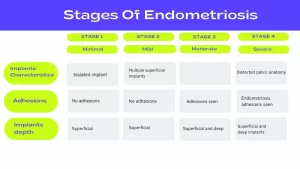- Best PCD Pharma Franchise Company
- +91 9216295095
- hcareindia@gmail.com
Learned to Live with Endometriosis

Are You Stressed Out Due to Infertility

How to establish a successful Pharma PCD Franchise
Table of Contents
ToggleEndometriosis
Endometriosis is a condition where tissue similar to that of the uterus grows outside the uterus. It’s difficult to know the root cause of it.
Endometrial tissues are hormonally active, where every month cyclical changes occur, leading to excess bleeding. As no passage to be released outside, inflammatory markers are released causing inflammation.
This causes pelvic pain (dysmenorrhea) and infertility (due to adhesions).
Various pigmented lesions (red, blue-black) and adhesions (due to inflammation) are seen in patients of endometriosis.
Most of the women during normal periods deal with mood swings, bloating and cramps but women with endometriosis often find period pain unbearable.
Therefore, endometriosis is:
- Benign condition
- Inflammatory condition
- Estrogen dependent condition
- In post menopausal females it undergoes regression
Clinical Symptoms of Endometriosis
Endometriosis reduces your fertility in many ways. Pelvic pain is the most common symptom of it. You may also have the following symptoms—
- Painful periods (secondary dysmenorrhea): most common symptom in 80% patients
- Heavy menstrual bleeding or bleeding between periods
- Infertility (20% patients)
- Adnexal mass (20% patients)
Less Common Symptoms
- Uterine bleeding (hormonally active causing heavy or prolonged bleeding)
- Pain while urination, increased frequency / urgency
- Painful defecation, constipation, diarrhoea
- Bleeding during menstruation other than vagina due to endometriosis
Examination of Endometriosis
- If Uterus: Fixed and retroverted
- Adnexal mass (due to chocolate cyst)
- Endometrial tissues leading to adhesion formation
- Formation of nodules
Investigation of Endometriosis
Endometriosis is investigated through following methods:
- Ultrasound: TVS / Transvaginal Sonography
- CA 125: Non specific marker, raised in endometriotic condition
- MRI Scan: Not done in routine. It is done to accurately diagnose the type of endometriosis.
- Bowel / Thoracic / Rectovaginal / Bladder / Ureter endometriosis
*Laparoscopy: It is an investigation of choice for the staging of this condition. If medical management is not working. Sample is sent for histopathology.
*Histopathology: It is the standard method for diagnosing endometriosis.
It is important to get regular check-ups. Allow your gynaecologist to provide quick relief from pain and other symptoms. This condition has no cure if left untreated. It can cause challenges in your day-to-day activities. Its symptoms are manageable.
Everyone reacts differently to these treatment options. Your doctor will help you find the one that works best for you.
Stages of Endometriosis

Management of Endometriosis
- Pain medications– You can try over-the-counter pain medications such as ibuprofen etc.
Hormone therapy– Taking supplemental hormones can sometimes relieve pain and stop the progression of it. Hormone therapy helps your body regulate the monthly hormonal changes that promote the tissue growth that occurs with it. - Hormonal contraceptives– Birth control pills can reduce or even eliminate the pain in less severe condition. The medroxyprogesterone injection is also effective in stopping menstruation. It stops the growth of endometrial implants. It relieves pain and other symptoms. This may not be the first choice. It causes the risk of weight gain, decreased bone production and an increased incidence of depression in some cases.
- Gonadotropin-releasing hormone (GnRH) agonists and antagonists– These are taken to block the production of estrogen which stimulates the ovaries. Estrogen is the hormone that is mainly responsible and blocking its production prevents menstruation and creates artificial menopause.
- Lifestyle changes– Diet, stretching and yoga can calm your body.
Laparoscopy in Endometriosis
If first line of drugs: Continuous GnRH agonist or GnRH antagonist ⇒ No relief ⇒ then Laparoscopy
It is done in moderate to severe pain. It helps in diagnosing and staging of it. It can also be used in surgical and therapeutic management of pain.
Indications of the use of Laparoscopy are:
- Not relieved by other methods
- Deeply infiltrating endometriosis, not responding to medical treatment or leading to obstruction
Doctor’s call
According to a Gynaecologist, “nothing permanently cures endometriosis but birth control pills do treat it by regulating your hormones and preventing you from bleeding. So, they are a good option, but not a cure.,” she explained.
“Another misconception is the belief that hysterectomy is a cure for it. By definition, it occurs when cells similar to the uterine lining develop in other parts of the body outside the uterus. The hormonal changes during your menstrual cycle causes the endometrial tissue to grow, thicken and eventually break. Over time, the tissue that has broken down has nowhere to go. It is trapped in your pelvis and causes pain,” she went on to explain. Moreover, she added, “some of the most effective treatment options have the risk of severe and long-term side effects. We often have to weigh whether it’s worth trying or not”.
Getting a diagnosis and starting treatment options early in the disease can be challenging. Coping with symptoms like stress due to infertility issues and pain coupled with fear can be stressful. Taking the above-mentioned steps can be helpful in creating a well-balanced approach in managing the condition.
